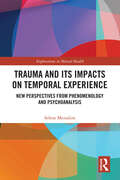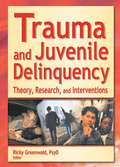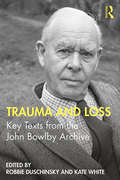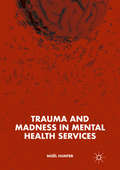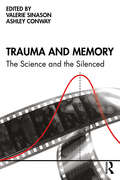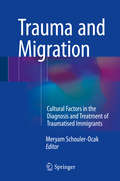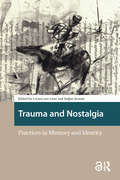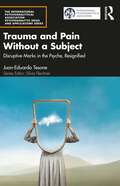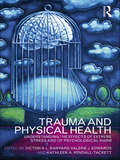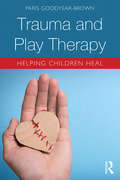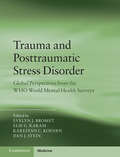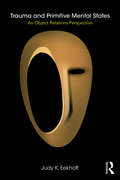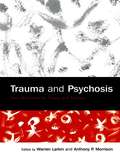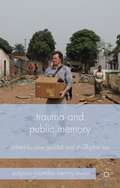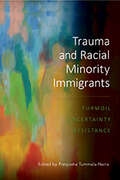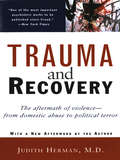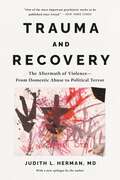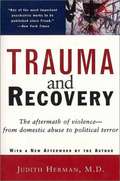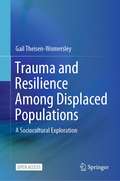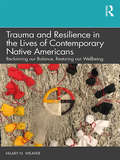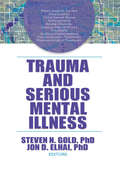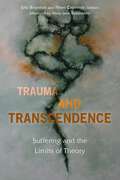- Table View
- List View
Trauma and Its Impacts on Temporal Experience: New Perspectives from Phenomenology and Psychoanalysis (Explorations in Mental Health)
by Selene MezzaliraThis unique text develops an original theoretical framework for understanding the relationship between trauma and time by combining phenomenological and psychoanalytical traditions. Moving beyond Western psychoanalytical and phenomenological traditions, this volume presents new perspectives on the assessment and treatment of trauma patients. Powerfully illustrating how the temporal dimension of a patient’s symptoms has until now been overlooked, the text presents a wealth of research literature to deepen our understanding of how trauma disrupts individual temporal experience. Ultimately, the resulting phenomena that occur (including dissociation and cognitive distortions) position time as a transdiagnostic psychological dimension, closely connected to the subject’s sense of self. This text will benefit researchers, academics, and educators with an interest in psychoanalysis, phenomenology, and trauma and dissociation studies more broadly. Those specifically interested in the philosophy of the mind, Freud, and psychotherapy will also benefit from this book.
Trauma and Juvenile Delinquency: Theory, Research, and Interventions
by Ricky GreenwaldLearn how and why trauma is relevant to juvenile delinquency-and what to do about it! This groundbreaking book addresses the connection between childhood trauma and juvenile delinquency. Trauma and Juvenile Delinquency: Theory, Research, and Interventions begins with two chapters presenting theoretical models of the relationship between trauma and the development/persistence of antisocial behavior. Another chapter addresses trauma-related assessment issues for juveniles, and several chapters present cutting-edge research on various aspects of the relationship between trauma and delinquency. Finally, several chapters focus on theory-based and empirically supported trauma-focused therapeutic interventions for juvenile delinquents. No other single source provides such breadth and depth of coverage on this topic! From the editor: "Disruptive behavior disorders are by far the largest type of mental health referral for children and adolescents, while juvenile crime and violence continue to be major social concerns. Several bodies of literature have converged to suggest that trauma is more than incidental to the problem of juvenile delinquency, it contributes to the problem." Trauma and Juvenile Delinquency: Theory, Research, and Interventions explores: how trauma relates to conduct disorder the connection between traumatic victimization and oppositional/defiance problems ways to assess PTSD in adolescents how exposure to violence, delinquent activity, and posttraumatic stress symptomatology are related the unique trauma histories of incarcerated girls and the problems they have adjusting to life within the juvenile justice system how to develop group therapy services for incarcerated male juvenile offenders with PTSD This valuable book also examines the effectiveness of EMDR (Eye Movement Desensitization and Reprocessing) for boys with conduct problems, MASTR (Motivation - Adaptive Skills - Trauma Resolution) for teens with school-related problems, and CPT (Cognitive Processing Therapy) for juvenile delinquents with post-traumatic stress disorder.
Trauma and Lived Religion: Transcending the Ordinary (Palgrave Studies in Lived Religion and Societal Challenges)
by R. Ruard Ganzevoort Srdjan SremacThis book focuses on the power of the ‘ordinary’, ‘everydayness’ and ‘embodiment’ as keys to exploring the intersection of trauma and the everyday reality of religion. It critically investigates traumatic experiences from a perspective of lived religion, and therefore, examines how trauma is articulated and lived in the foreground of people’s concrete, material actualities. Trauma and Lived Religion seeks to demonstrate the vital relevance between the concept of lived religion and the study of trauma, and the reciprocal relationship between the two. A central question in this volume therefore focuses on the key dimensions of body, language, memory, testimony, and ritual. It will be of interest to academics in the fields of sociology, psychology, and religious studies with a focus on lived religion and trauma studies, across various religions and cultural contexts.
Trauma and Loss: Key Texts from the John Bowlby Archive
by Kate White Robbie DuschinskyDuring his lifetime John Bowlby, the founder of attachment theory, was unable to publish as he wished due to strong opposition to his ideas. Now, with the support of the Bowlby family, several complete and near-complete works from the John Bowlby Archive at the Wellcome Collection are published for the first time. The collection spans Bowlby’s thinking from his early ideas to later reflections, and is split into four parts. Part 1 includes essays on the topic of loss, mourning and depression, outlining his thoughts on the role of defence mechanisms. Part 2 covers Bowlby’s ideas around anxiety, guilt and identification, including reflections on his observations of and work with evacuated children. Part 3 features three seminars on the subject of conflict, in which Bowlby relates clinical concepts to both political philosophy and psychoanalysis in innovative ways. Part 4 consists of Bowlby’s later reflections on trauma and loss, and on his own work as a therapist. This remarkable collection not only clarifies Bowlby’s relationship with psychoanalysis but features his elaboration of key concepts in attachment theory and important moments of self-criticism. It will be essential reading for clinicians, researchers, and others interested in human development, relationships and adversity.
Trauma and Madness in Mental Health Services
by Noël HunterHow do survivors of child abuse, bullying, chronic oppression and discrimination, and other developmental traumas adapt to such unimaginable situations? It is taken for granted that experiences such as hearing voices, altered states of consciousness, dissociative states, lack of trust, and intense emotions are inherently problematic. But what does the evidence actually show? And how much do we still need to learn?
Trauma and Memory
by Peter A. Levine Bessel A. van der KolkIn Trauma and Memory, bestselling author Dr. Peter Levine (creator of the Somatic Experiencing approach) tackles one of the most difficult and controversial questions of PTSD/trauma therapy: Can we trust our memories? While some argue that traumatic memories are unreliable and not useful, others insist that we absolutely must rely on memory to make sense of past experience. Building on his 45 years of successful treatment of trauma and utilizing case studies from his own practice, Dr. Levine suggests that there are elements of truth in both camps. While acknowledging that memory can be trusted, he argues that the only truly useful memories are those that might initially seem to be the least reliable: memories stored in the body and not necessarily accessible by our conscious mind.While much work has been done in the field of trauma studies to address "explicit" traumatic memories in the brain (such as intrusive thoughts or flashbacks), much less attention has been paid to how the body itself stores "implicit" memory, and how much of what we think of as "memory" actually comes to us through our (often unconsciously accessed) felt sense. By learning how to better understand this complex interplay of past and present, brain and body, we can adjust our relationship to past trauma and move into a more balanced, relaxed state of being. Written for trauma sufferers as well as mental health care practitioners, Trauma and Memory is a groundbreaking look at how memory is constructed and how influential memories are on our present state of being.
Trauma and Memory: The Science and the Silenced
by Valerie SinasonTrauma and Memory will assist mental health experts and professionals, as well as the interested public, in understanding the scientific issues around trauma memory, and how this differs from other areas of memory. This book provides accounts of the damage caused to psychology and survivors internationally by false memory groups and ideas. It is unequivocally passionate about the truth of trauma memory and exposing the damaging disinformation that can seep into the field. Contributors to this book include leading professionals from the field of criminology, law, psychology and psychotherapy in the UK and USA, along with survivor-professionals who understand only too well the damage such disinformation can cause. This book is a valuable resource for mental health professionals of all disciplines including those involved with relevant law and public health policy. It will also help survivors and survivor-professionals in gaining insight into the forces resisting disclosure.
Trauma and Migration
by Meryam Schouler-OcakThis book provides an overview of recent trends in the management of trauma and post-traumatic stress disorders that may ensue from distressing experiences associated with the process of migration. Although the symptoms induced by trauma are common to all cultures, their specific meaning and the strategies used to deal with them may be culture-specific. Consequently, cultural factors can play an important role in the diagnosis and treatment of individuals with psychological reactions to extreme stress. This role is examined in detail, with an emphasis on the need for therapists to bear in mind that different cultures often have different concepts of health and disease and that cross-cultural communication is therefore essential in ensuring effective care of the immigrant patient. The therapist's own intercultural skills are highlighted as being an important factor in the success of any treatment and specific care contexts and the global perspective are also discussed.
Trauma and Nostalgia: Practices in Memory and Identity (Heritage and Memory Studies)
by Srdjan Sremac Lucien Van LiereThis volume reflects on the significance of nostalgia in the construction of traumatic pasts, both on an individual and a collective level. By employing an interdisciplinary approach, the volume enhances our understanding of how the entanglements of trauma and nostalgia influence the construction and development of identity. Scholars from a range of academic disciplines and contexts explore the integration of nostalgic memories in discussions of trauma, attending to their interactions in public spaces, patriotic symbolism and rituals, popular culture, cinema, religion, museums, and memorials. The contributors emphasize the role of media and other mass-cultural technologies in disseminating images and narratives related to traumatic and nostalgic experiences. These essays ultimately bring to light the frequently overlooked role of nostalgic longing in shaping the discursive, visual, and material aspects of collective trauma.
Trauma and Organizations (The New International Library of Group Analysis)
by Earl HopperThis book is concerned with the study of organizations of various kinds. It examines the patterns of conscious and unconscious life of those organizations in which traumatic experience is ubiquitous and understanding the variations in individual, group, and organizations.
Trauma and Pain Without a Subject: Disruptive Marks in the Psyche, Resignified (The International Psychoanalytical Association Psychoanalytic Ideas and Applications Series)
by Juan-Eduardo TesoneTrauma and Pain Without a Subject explores the necessity of the subject of trauma emerging, particularly when a victim has experienced but not worked through disruptive situations, in order for unconscious pain to finally be experienced.The book is presented in three parts, with the first, "Transgression and Crime", uncovering silence around the topic of incest and sexual violence within the clinic. The second part, "Between Completeness and Nothingness", develops the topic of sexual violence and considers the construction of femininities and masculinities within the paradigm of a heteronormative patriarchal society, with reference to Shakespeare’s Much Ado About Nothing. The third part, “Yes, We See, But What? What We Hear”, explores the intimate relation between the visual and the auditory, especially in relation to hysteria.Trauma and Pain Without a Subject will be of great interest to psychoanalysts in practice and in training, and to all psychoanalytic practitioners working with trauma.
Trauma and Physical Health: Understanding the Effects of Extreme Stress and of Psychological Harm
by Kathleen A. Kendall-Tackett Victoria Banyard Valerie EdwardsTrauma research and clinical practice have taught us much about the widespread problems of child maltreatment, partner violence, and sexual assault. Numerous investigations have documented links between such trauma exposure and long-term negative mental health consequences. As we learn more about traumatic stress, however, increasing attention has been drawn to the less studied physical health effects of maltreatment and trauma. Trauma and Physical Health describes both the negative physical health effects of victimization in childhood as well as exploring theoretical models that explains these links. By bringing together new and current studies on the relationship between trauma and physical health, this edited collection assesses the clinical implications of these links. At a time when the mental health field is becoming increasingly cognizant of the value of collaboration with professionals in the physical health arena, this book suggests ways in which clinicians can work with primary care professionals to better meet the needs of trauma survivors across the lifespan. A key focus of the text is to clarify the relationship between the current knowledge base in trauma and physical health and directions for future research in primary care health settings. With contributors from a wide range of clinical and psychological disciplines, it will be of interest to researchers, clinicians and professionals in the trauma field and to primary care professionals concerned with compassionate care for the traumatized.
Trauma and Play Therapy: Helping Children Heal
by Paris Goodyear-BrownTrauma and Play Therapy synthesizes new developments in the study of children’s trauma recovery to assist clinicians in combining play therapy with other powerful ways of addressing the needs of hurt children. The TraumaPlayTM model, formerly known as Flexibly Sequential Play Therapy, equips practitioners to manage and adapt aspects of the play therapy place and process in order to help children tell their stories while draining the emotional toxicity from traumatic experiences. Chapters explore the neurobiological and developmental foundations of play therapy as well as strategies for navigating children’s trauma in relation to specific aspects of play therapy such as sensory integration, metaphor, and humor. Enriched by a tapestry of illustrative case examples and tools for therapists, this is a vital new book for clinicians working at the intersection of play and children’s trauma.
Trauma and Posttraumatic Stress Disorder: Global Perspectives from the WHO World Mental Health Surveys
by Dan Stein Evelyn Bromet Elie Karam Karestan KoenenPosttraumatic Stress Disorder (PTSD) is a chronic, under-detected and under-treated psychiatric consequence of trauma that is often linked to new-onset medical and psychological conditions, impaired quality of life and long-term disability across the globe. This book is the first systematic analysis of the rates, risk factors, consequences and global burden of trauma and PTSD across a variety of wealthy and underdeveloped settings. An analysis of a global survey conducted by the World Health Organization and featuring findings from over 70,000 participants around the world, this text demonstrates a unique perspective on the prevalence of exposure to trauma and PTSD and the impact it has on population health. The findings inside this text underscore the urgent need for policymakers and healthcare providers to prioritize interventions aimed at reducing the burden of trauma, PTSD and its consequences.
Trauma and Primitive Mental States: An Object Relations Perspective (The\routledge Wilfred R. Bion Studies Book Ser.)
by Judy K. EekhoffTrauma and Primitive Mental States: An Object Relations Perspective offers a clinically based framework through which adult survivors of early childhood trauma can re-engage with painful past events to create meaningful futures for themselves. The book highlights the use of the body and the mind in working with these early unmentalized and unrepresented states, illustrating the value of finding language that embodies emotions, and working in the here and now of transference and counter-transference. Including a range of examples of how early trauma can thus be re-presented and clinically understood, the book illustrates how patients can discover themselves and leave their repetitive patterns of suffering behind. Written by a clinician with over 30 years’ experience, this will be fascinating reading for psychoanalysts and psychotherapists as well as any mental health professional working with childhood trauma.
Trauma and Psychosis: New Directions for Theory and Therapy
by Anthony P. Morrison Warren LarkinTrauma and Psychosis provides a valuable contribution to the current understanding of the possible relationships between the experience of trauma and the range of phenomena currently referred to as psychosis. Warren Larkin and Anthony P. Morrison bring together contributions from leading clinicians and researchers in a range of fields including clinical psychology, mental health nursing and psychiatry. The book is divided into three parts, providing comprehensive coverage of the relevant research and clinical applications. Part I: Research and Theoretical Perspectives provides the reader with a broad understanding of current and developing theoretical perspectives. Part II: Specific Populations examines the relationship between trauma and psychotic experiences in specific populations. Part III: From Theory to Therapy draws together current knowledge and investigates how it might be used to benefit individuals experiencing psychosis. This book will be invaluable for clinicians and researchers interested in gaining a greater insight into the interaction between trauma and psychosis.
Trauma and Public Memory
by Jane Goodall Christopher LeeThis collection explores the ways in which traumatic experience becomes a part of public memory. It explores the premise that traumatic events are realities; they happen in the world, not in the fantasy life of individuals or in the narrative frames of our televisions and cinemas.
Trauma and Racial Minority Immigrants: Turmoil, Uncertainty, and Resistance (Cultural, Racial, and Ethnic Psychology Series)
by Pratyusha Usha Tummala-NarraThis book teaches the impact of the sociopolitical climate on racial minority immigrants, as well as highlights theory, research, and practice concerning the various types of trauma and oppression faced. For racial minority immigrants in the United States, trauma can have both historical and ongoing sources. Today&’s immigrants face a dangerous mix of rising nationalism and xenophobia, alarming rates of displacement within and across nations, war, trafficking, terrorism, and deportation. Multiple traumas stem from these experiences and can be exacerbated by interpersonal violence and other forms of marginalization within communities. This book examines the lasting impact of trauma for racial minority immigrants and subsequent generations. Each chapter explores both the stress and resilience of immigrant groups in the United States, as well as clinical or community-based efforts to address the multiple traumas that affect immigrants and their children. While considering the socioecological contexts of immigrants, the chapters reflect a diversity of theoretical perspectives needed to expand existing treatments for trauma, such as multicultural, feminist, womanist, psychodynamic, cognitive-behavioral, and humanistic theories. In the nuanced pages of this book, you will deepen your understanding of the immigrant experience and develop professional skills to help heal traumatic stress faced by racial minority immigrants.
Trauma and Recovery
by Judith L. HermanWhen Trauma and Recovery was first published in 1992, it was hailed as a groundbreaking work. In the intervening years, Herman's volume has changed the way we think about and treat traumatic events and trauma victims. In a new afterword, Herman chronicles the incredible response the book has elicited and explains how the issues surrounding the topic have shifted within the clinical community and the culture at large.Trauma and Recovery brings a new level of understanding to a set of problems usually considered individually. Herman draws on her own cutting-edge research in domestic violence as well as on the vast literature of combat veterans and victims of political terror, to show the parallels between private terrors such as rape and public traumas such as terrorism. The book puts individual experience in a broader political frame, arguing that psychological trauma can be understood only in a social context. Meticulously documented and frequently using the victims' own words as well as those from classic literary works and prison diaries, Trauma and Recovery is a powerful work that will continue to profoundly impact our thinking.
Trauma and Recovery: The Aftermath of Violence, from Domestic Abuse to Political Terror
by Judith Lewis HermanWhen Trauma and Recovery was first published in 1992, it was hailed as a groundbreaking work. In the intervening years, it has become the basic text for understanding trauma survivors. By placing individual experience in a broader political frame, Judith Herman argues that psychological trauma can be understood only in a social context. Drawing on her own research on incest, as well as on a vast literature on combat veterans and victims of political terror, she shows surprising parallels between private horrors like child abuse and public horrors like war. A new epilogue reviews what has changed--and what has not changed--over two decades. Trauma and Recovery is essential reading for anyone who seeks to understand how we heal and are healed.
Trauma and Recovery: The Aftermath of Violence--from Domestic Abuse to Political Terror
by Judith Lewis Herman<p>When <i>Trauma and Recovery</i> was first published in 1992, it was hailed as a groundbreaking work. In the intervening years, Herman's volume has changed the way we think about and treat traumatic events and trauma victims. In a new afterword, Herman chronicles the incredible response the book has elicited and explains how the issues surrounding the topic have shifted within the clinical community and the culture at large. <p><i>Trauma and Recovery</i> brings a new level of understanding to a set of problems usually considered individually. Herman draws on her own cutting-edge research in domestic violence as well as on the vast literature of combat veterans and victims of political terror, to show the parallels between private terrors such as rape and public traumas such as terrorism. <p>The book puts individual experience in a broader political frame, arguing that psychological trauma can be understood only in a social context. Meticulously documented and frequently using the victims' own words as well as those from classic literary works and prison diaries, <i>Trauma and Recovery</i> is a powerful work that will continue to profoundly impact our thinking.</p>
Trauma and Resilience Among Displaced Populations: A Sociocultural Exploration
by Gail Theisen-WomersleyThis open access book provides an enriched understanding of historical, collective, cultural, and identity-related trauma, emphasising the social and political location of human subjects. It therefore presents a socio-ecological perspective on trauma, rather than viewing displaced individuals as traumatised “passive victims”. The vastness of the phenomenon of trauma among displaced populations has led it to become a critical and timely area of inquiry, and this book is an important addition to the literature. It gives an overview of theoretical frameworks related to trauma and migration—exploring factors of risk and resilience, prevalence rates of PTSD, and conceptualisations of trauma beyond psychiatric diagnoses; conceptualises experiences of trauma from a sociocultural perspective (including collective trauma, collective aspirations, and collective resilience); and provides applications for professionals working with displaced populations in complex institutional, legal, and humanitarian settings. It includes case studies based on the author’s own 10-year experience working in emergency contexts with displaced populations in 11 countries across the world. This book presents unique data collected by the author herself, including interviews with survivors of ISIS attacks, with an asylum seeker in Switzerland who set himself alight in protest against asylum procedures, and women from the Murle tribe affected by the conflict in South Sudan who experienced an episode of mass fainting spells. This is an important resource for academics and professionals working in the field of trauma studies and with traumatised groups and individuals.
Trauma and Resilience in the Lives of Contemporary Native Americans: Reclaiming our Balance, Restoring our Wellbeing
by Hilary N. WeaverIndigenous Peoples around the world and our allies often reflect on the many challenges that continue to confront us, the reasons behind health, economic, and social disparities, and the best ways forward to a healthy future. This book draws on theoretical, conceptual, and evidence-based scholarship as well as interviews with scholars immersed in Indigenous wellbeing, to examine contemporary issues for Native Americans. It includes reflections on resilience as well as disparities. In recent decades, there has been increasing attention on how trauma, both historical and contemporary, shapes the lives of Native Americans. Indigenous scholars urge recognition of historical trauma as a framework for understanding contemporary health and social disparities. Accordingly, this book uses a trauma-informed lens to examine Native American issues with the understanding that even when not specifically seeking to address trauma directly, it is useful to understand that trauma is a common experience that can shape many aspects of life. Scholarship on trauma and trauma-informed care is integrated with scholarship on historical trauma, providing a framework for examining contemporary issues for Native American populations. It should be considered essential reading for all human service professionals working with Native American clients, as well as a core text for Native American studies and classes on trauma or diversity more generally.
Trauma and Serious Mental Illness
by Jon D. Elhai Steven N. GoldAn exploration of the newfound connections between mental illness and trauma For decades, the idea that serious mental illnesses (SMIs) are almost exclusively biologically-based and must be treated pharmacologically has been commonplace in psychology literature. As a result, many mental health professionals have stopped listening to their clients, categorizing their symptoms as manifestations of neurologically-based disturbed thinking. Trauma and Serious Mental Illness is the groundbreaking series of works that challenge this standard view and provides a comprehensive introduction to the emerging perspective of SMIs as trauma-based. This unique collection illustrates how different psychotherapy approaches can lead to reduced symptomatology, decreased psychological distress, and improved functioning in individuals living with SMIs. Each extensively-referenced chapter in Trauma and Serious Mental Illness offers mental health workers a forward-looking theoretical inquiry, empirical study, or critical treatise providing compelling counter evidence to challenge the widespread belief that SMIs are not reactions to the extreme and extremely disturbing circumstances embodied by psychological trauma. In addition to the etiological application, this revealing text proposes ways to incorporate this cutting-edge approach toward treatment options as well. Contributors to Trauma and Serious Mental Illness suggest that: childhood trauma is related to psychotic disorders dissociation can be confounded with psychotic symptoms auditory hallucinations can be diagnostic of dissociation rather than psychosis psychosis is related to the quality of family of origin environment and to age of onset of childhood abuse bipolar and trauma-related disorders sometimes overlap individuals with SMIs suffer related trauma even in treatment facilities and much more!Trauma and Serious Mental Illness is an eye-opening resource for mental health professionals, psychologists, counselors, psychiatrists, social workers, trauma workers, and educators and students in these disciplines.
Trauma and Transcendence: Suffering and the Limits of Theory
by Eric Boynton and Peter CaprettoTrauma theory has become a burgeoning site of research in recent decades, often demanding interdisciplinary reflections on trauma as a phenomenon that defies disciplinary ownership. While this research has always been challenged by the temporal, affective, and corporeal dimensions of trauma itself, trauma theory now faces theoretical and methodological obstacles given its growing interdisciplinarity. Trauma and Transcendence gathers scholars in philosophy, theology, psychoanalysis, and social theory to engage the limits and prospects of trauma’s transcendence. This volume draws attention to the increasing challenge of deciding whether trauma’s unassimilable quality can be wielded as a defense of traumatic experience against reductionism, or whether it succumbs to a form of obscurantism.Contributors: Eric Boynton, Peter Capretto, Tina Chanter, Vincenzo Di Nicola, Ronald Eyerman, Donna Orange, Shelly Rambo, Mary-Jane Rubenstein, Hilary Jerome Scarsella, Eric Severson, Marcia Mount Shoop, Robert D. Stolorow, George Yancy.
